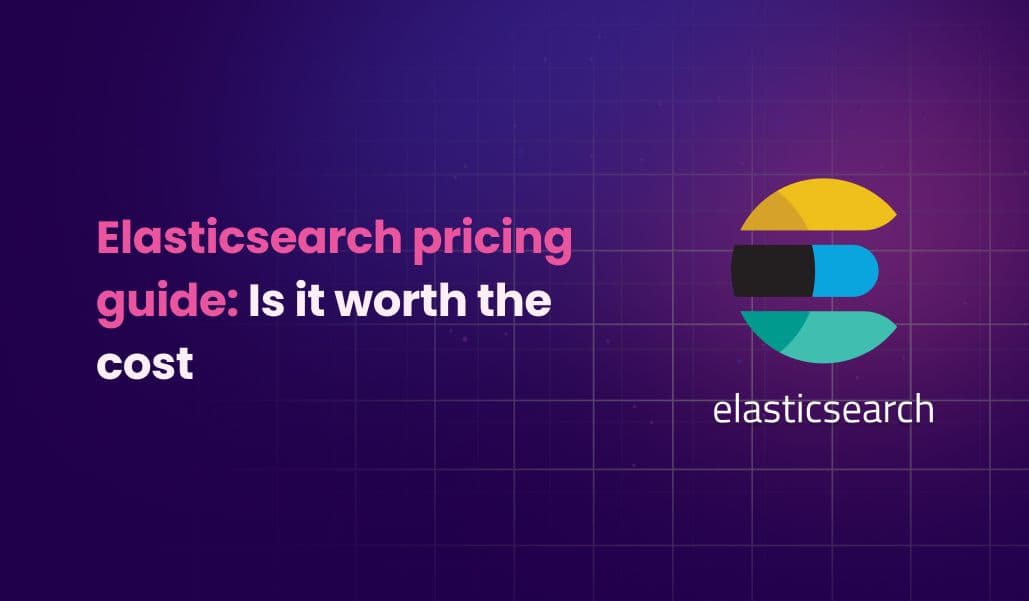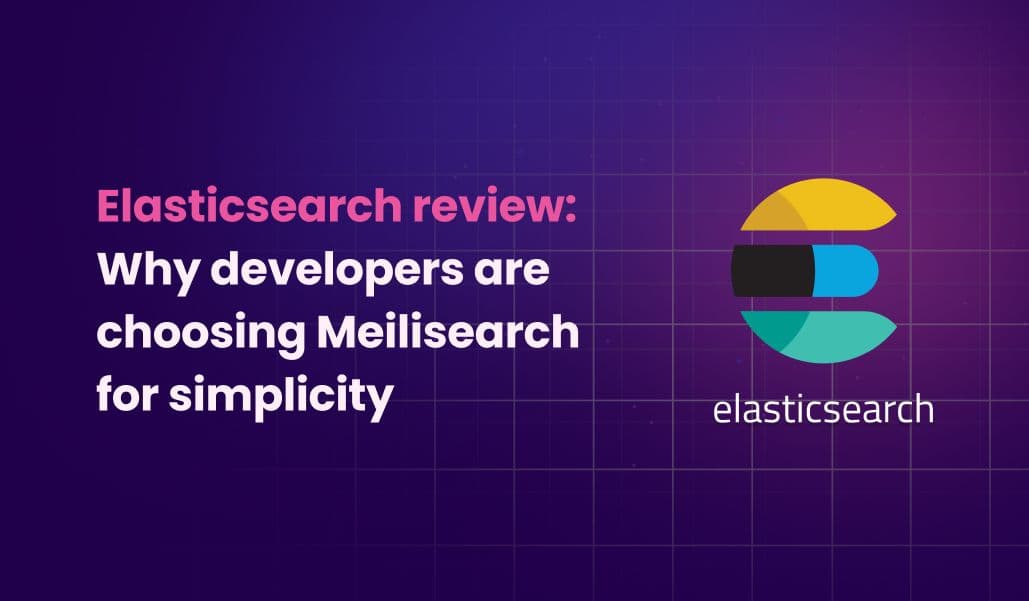Semantic search vs Vector search: Key differences, uses, & more
Discover the key differences between semantic and vector search, their use cases, strengths, and how to choose the right approach for your search needs.

In this article
Vector search and semantic search may appear similar, but they solve different problems.
Vector search finds similar content by converting text into high-dimensional vectors and comparing them.
Semantic search, on the other hand, understands the user's intent by leveraging knowledge graphs and contextual embeddings.
In this article, we will explore the difference between semantic search and vector search. Specifically, we will discuss:
- How semantic search and vector search work.
- The advantages and disadvantages of each.
- Real-world examples of semantic search and vector search.
- Factors affecting the accuracy of semantic search and vector search.
Let’s jump in.
What is semantic search?
Semantic search interprets the actual meaning of a query rather than using keywords. It uses machine learning and knowledge graphs to understand the context of the user’s query.
What is vector search?
Vector search is a retrieval method that converts unstructured data, such as text, images, or documents, into numerical embeddings and stores them in a vector index. When a user types in a query, vectors similar to the search query vectors are considered relevant and returned as results.
Both vector search and semantic search go beyond simple keyword matching and use meaning and context.
However, they differ in their approach.
What are the key differences between semantic search and vector search?
Semantic search and vector search both allow for smarter information retrieval. They might appear similar, but there are some key differences.
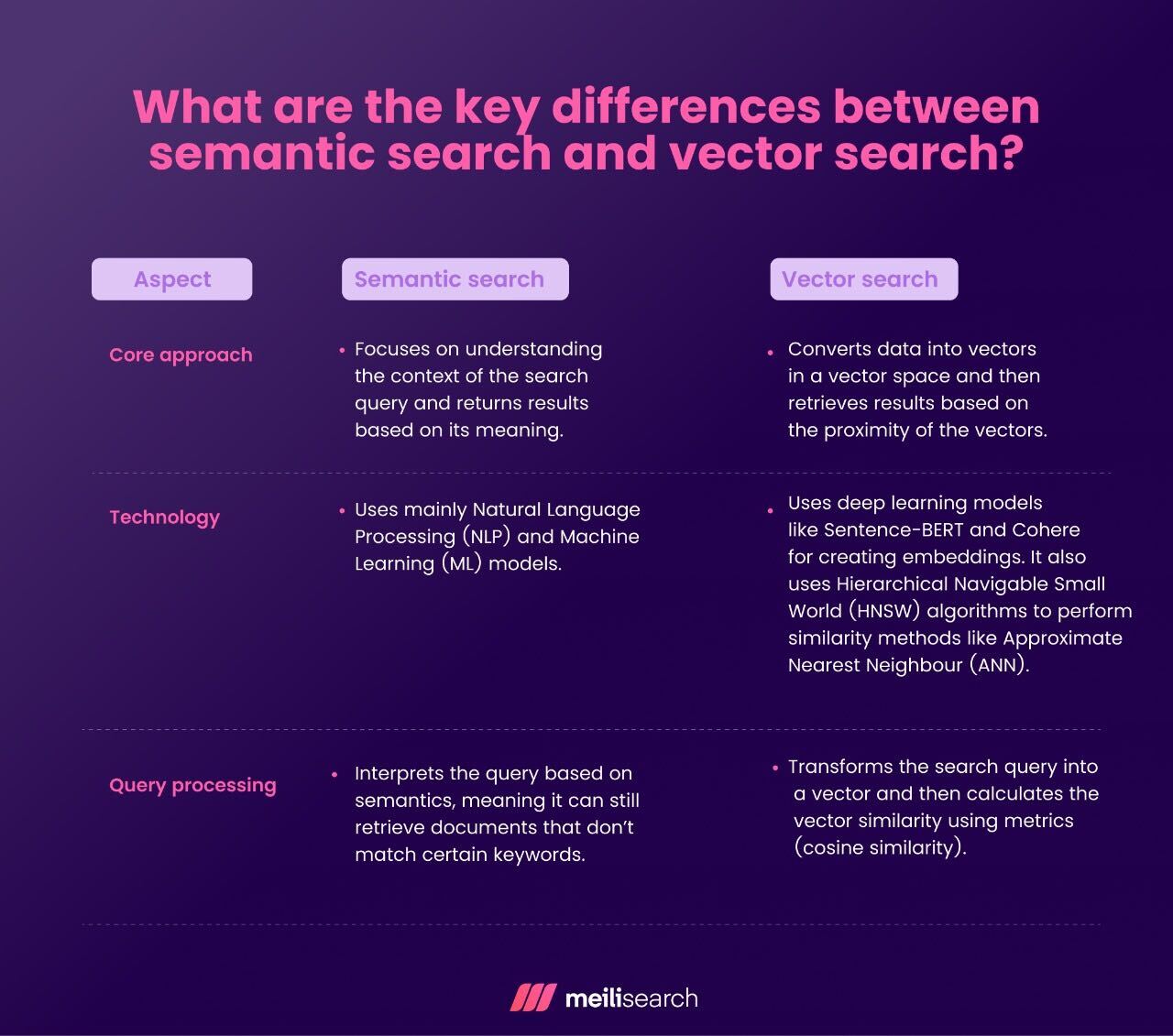
Core approach
Semantic search tries to understand your intentions based on the context of your query. It relies on this context, rather than just keywords, to return its results.
Vector search, in contrast, converts your query into vectors and finds results that are closest in meaning based on those vectors.
Technology
Semantic search uses tools like natural language processing to understand your words and their connections.
Vector search uses deep learning models such as Sentence-BERT to create number-based representations of the query. It then uses smart algorithms, like HNSW, to quickly find what is most similar in large datasets.
Query processing
Semantic search interprets your query like a human, considering meaning and context.
Vector search, however, is number-focused. Your query is converted to a vector, and similar vectors are considered a match.
How does semantic search work?
Semantic search uses the following steps to function correctly:
- Query components analysis: Semantic search identifies the main components of the search query (keywords, phrases, and key entities). For example, in a query like ‘best boots to play soccer,’ NLP techniques identify that ‘boots’ is the primary entity and ‘soccer’ is the intent driver.
- Converting query components to vector embeddings: The components are converted to high-dimensional vectors through vector embeddings.
- Calculating vector similarities: Here, the proximity of vectors is determined using metrics like cosine similarity. This helps identify documents related to the search query.
- Associating the query with a knowledge graph: The query is checked against a knowledge graph to provide more context. A knowledge graph represents entities as nodes and their relationship as edges. Thus, related concepts are linked together. For example, ‘soccer’ can be linked to ‘defender’ or ‘midfielder.’
- Results ranking: Finally, the results from vector embeddings or knowledge graphs (or both) are ranked to return the most relevant results.
How does vector search work?
Vector search uses embedding models to convert data into numerical vectors stored in a vector database. During a query, it transforms the query into a vector and retrieves the stored vectors that are most similar.
Here’s how vector search retrieves results:
- Storing vector embeddings: Before performing a search, all relevant items (text, images, etc.) are converted into vector embeddings and stored in a vector database.
- Converting the search query to an embedding: When a user submits a query, the query is also transformed into a vector embedding using the same embedding model.
- Searching for similar embeddings: The model then compares the query embedding with the stored embeddings to find the most similar.
- Returning results: The most similar items are ranked and returned.
Because this search requires computing distances from the query to every point in the dataset, implementing vanilla vector search at scale can be impractical. To speed up the process for large datasets, approximate nearest neighbor (ANN) algorithms are used.
Let’s look at the advantages of semantic search over vector search.
What are the advantages of semantic search vs. vector search?
Semantic and vector searches aim to ensure accurate and smarter searches, but they achieve that differently.
Here are some of their advantages to help you compare their strengths.

Semantic search
Here are some benefits of using semantic search:
- Improved user experience: Unlike traditional keyword search, semantic search retrieves more relevant and accurate results even when you input a partial search query. It also uses location data, user preferences, and past searches to deliver personalized responses to a user’s search query.
- Bridging language barriers: Semantic search can interpret a user query in one language and return the results in another language. It uses multilingual embedding models that map queries and documents from different languages.
- Highly scalable: Semantic search can handle large volumes of data while keeping response times low. An embedding for each item is precomputed and stored in an efficient ANN index, allowing for quick query processing.
Vector search
Vector search also has its benefits:
- Flexible matching: Vector search finds relevant results based on meaning, not exact keywords, making the matching process flexible. For instance, the query ‘cleats for wingers’ can return results for ‘fast-paced soccer boots’ even when the word ‘wingers’ is missing from the title.
- Quick similarity search: The process of using vector search to find similar content in a high-dimensional vector space is faster than semantic search. Semantic search adds other steps (such as knowledge graph comparison) before returning the results.
- Scalability: It is designed to effectively handle a large amount of unstructured data.
- Multilingual awareness: A multilingual embedding model can support various languages across different data types (images, text, or audio).
- Advanced applications: Vector search finds applications in recommendation systems and content clustering fields.
What are the disadvantages of vector search vs. semantic search?
While both semantic and vector search have benefits, they are not without downsides.
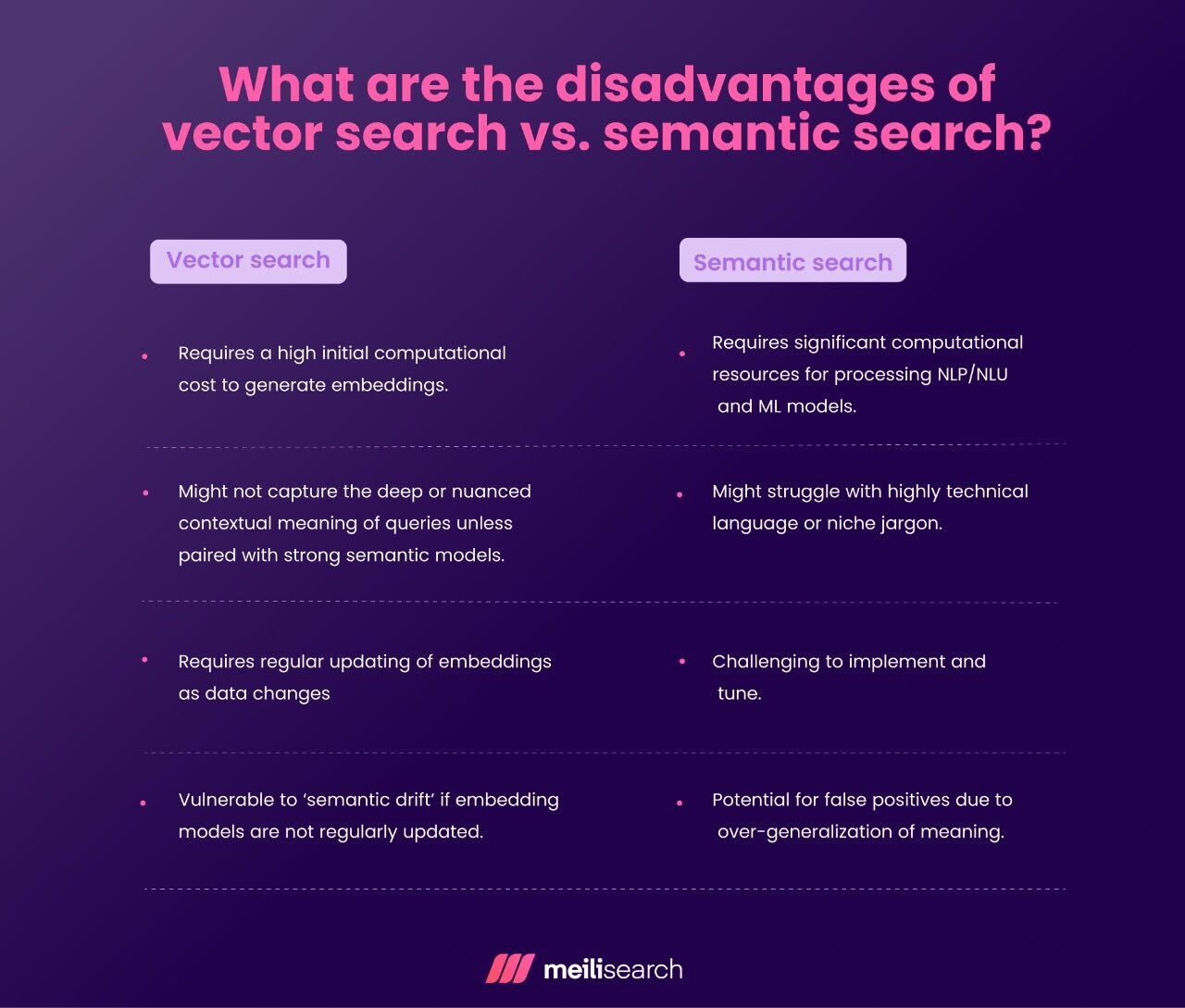
Vector search
Here are the key disadvantages of vector search:
- High initial computational cost: Generating embeddings requires high computing. Embedding millions of documents often means running on GPU clusters or high-performance CPUs for hours or even days.
- Limited context understanding: The success of vector search is as good as the embedding model used. The search result will be equally flawed if the embedding model lacks good contextual awareness.
- Requires re-embedding for data updates: Whenever the data changes, the embedding needs to be regenerated and reindexed to keep the vector search accurate.
- Risk of semantic drift: Semantic drift occurs when the meaning of a word or phrase changes over time. In such situations, the embedding models might not reflect the current meaning.
Semantic search
Let’s look at the disadvantages of semantic search:
- Requires significant computational resources: Because semantic search involves multiple steps, it requires even more computational power than vector search.
- May struggle with niche or technical jargon: The model might not understand technical terms if not trained in domain-specific languages. For instance, a search for ‘best PK takers’ may be confusing if it doesn't recognize PK as Penalty Kick.
- Complex to implement and tune: Building a semantic search system requires expertise. It involves selecting embedding models, training data, choosing the right indexing strategy, matching with a required knowledge graph, and interpreting queries.
- Risk of false positives due to over-generalization: Semantic models can sometimes return documents that are only loosely related to the query intent, leading to irrelevant results. For example, a query ‘boots for fast players’ might return results for ‘training shoes for speed drills’, which are not meant for soccer.
Both semantic and vector search require an index. Let’s now discuss semantic and vector indexes.
What is the difference between a semantic index and a vector index?
A semantic index builds embeddings using synonyms, intent signals, or domain knowledge to return its results. For example, a query like ‘curing headache’ might return an article titled ‘Paracetamol dosage guidelines’ because it understands that paracetamol is a standard treatment for headaches.
A vector index stores file embeddings and retrieves items purely by similarity. For the same query, ‘curing headache,’ it would return the nearest embedding, such as articles titled ‘Headache relief with ibuprofen,’ based solely on distance in vector space.
Simply put, a semantic index makes sense of your intent, while the vector index returns the nearest vectors to your query.
When should you use semantic search vs. vector search?
Semantic search is a good choice if you want to understand what users mean, not just what they type. It is best used for a question-answer or inquiry search system, such as in chatbots, customer service tools, or enterprise search platforms.
On the flip side, use vector search when speed and scalability are of the essence. Vector search is also great for large unstructured datasets, such as image or video searches or product recommendations. In these situations, the goal is to find similar items, not an exact match.
In many cases, the best solution is to combine semantic search for contextual understanding and vector search for similarity finding. Such search engines would ensure smarter and more accurate results.
Let’s see some real-world examples of semantic search and vector search.
What are real-world examples of semantic search?
Most advanced applications that require search systems use semantic search. Here are some of them:
- Conversational AI and chatbots: Semantic search enables chatbots to understand nuanced or unconventional queries. For instance, if you search ‘Why can’t I log into my Netflix account?’ the chatbot can return an article titled ‘Troubleshooting Login Problems on Netflix.’
- Enterprise knowledge management: Semantic search is used in large corporations where search results from internal documents focus on meaning rather than keywords.
- Search engines: Semantic search is widely used in search engines as it enhances intent-matched results.
- Medical research platforms: Semantic search enables contextual literature searches among medical researchers, who often use different terms to describe the same symptoms or treatments.
- E-commerce: Semantic search matches customer questions to product information, even if product descriptions use different terms. For example, a shopper on Amazon searches, ‘Jackets to keep me warm’, and it returns a product labelled ‘Insulated winter jackets’.
What are real-world examples of vector search?
Here are some real-world examples of vector search:
- Product recommendation systems: Vector search can help recommend products based on the user's preferences or the item's features. If you search ‘black sneakers,’ the system can suggest other sneakers with similar materials and styles. It can also use collaborative filtering to return sneakers that similar users buy.
- Large-scale document or FAQ retrieval: Vector search embeds user queries and documents into the same vector database and retrieves the top-K most relevant passages. This allows the LLM to generate precise, context-aware answers.
- Image and video search: Instead of searching by filenames or tags, vector search allows users to find visually similar content. It compares their features and retrieves those with close matches.
- Fraud detection: Vector search can identify anomalous transaction patterns by comparing them to known fraud patterns. For example, if someone makes a large purchase from a new location at an odd time, vector search can flag it as suspicious.
- Audio/music similarity search: Vector search converts audio into vectors using embeddings, enabling you to find similar songs or clips, even without matching titles.
Now, let's see the factors that can affect semantic and vector search accuracy.
What factors affect the accuracy of semantic search?
Here are some factors that influence the accuracy of semantic search.
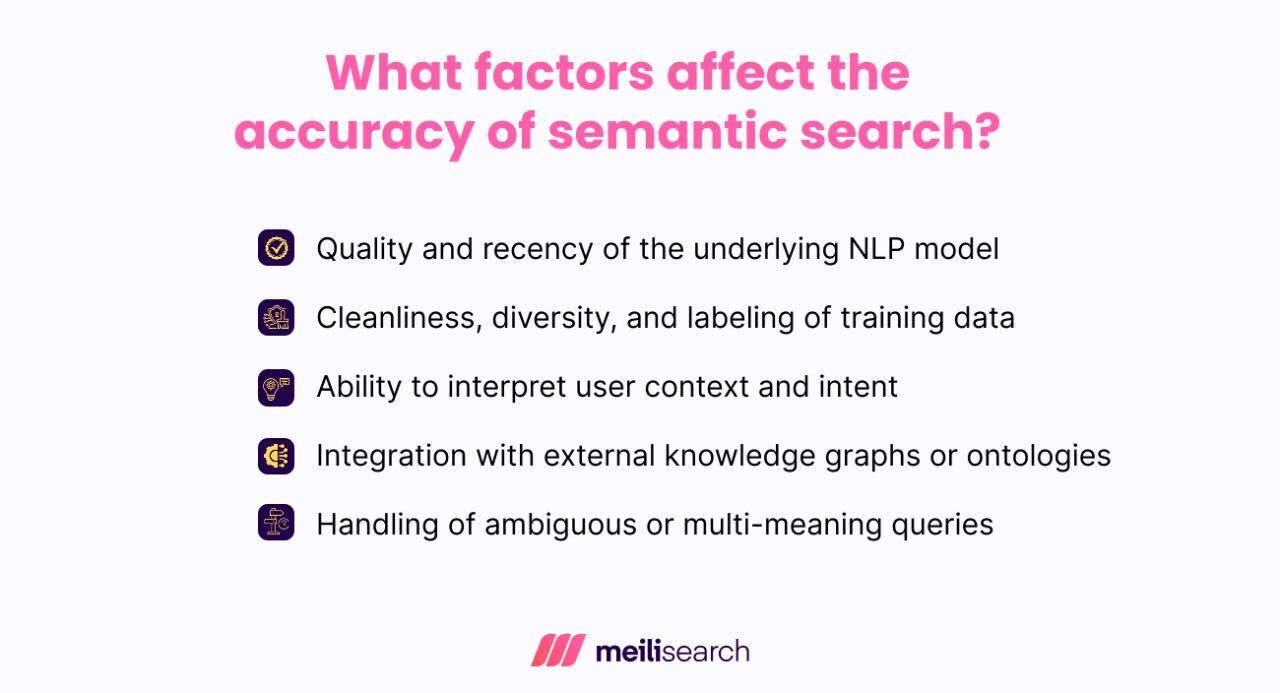
Quality and recency of the NLP model
Semantic search depends heavily on NLP models to understand language. If the model is outdated or not well-trained, it may miss newer slang, phrases, or evolving meanings, making the results less accurate.
Training data quality
The model is only as good as the data it's trained on. If the data is clean, diverse, and properly labeled, the system learns better. On the other hand, if the training data is messy and biased, the search accuracy tanks.
Understanding user intent
Sometimes, the search system struggles to identify what a user wants, especially with no clear context. Without that understanding, it might deliver unrelated results.
Use of knowledge graphs or ontologies
Connecting the search system to a knowledge graph helps it stay focused and accurate, especially in specialized topics. However, a shallow graph limits the quality of results.
Dealing with ambiguity
Many words have more than one meaning, and if the system cannot tell which meaning is being referred to, it may return wrong results. For instance, searching for ‘bat’ might bring up flying animals when you want baseball gear.
What factors affect the accuracy of vector search?
Getting accurate results from vector search is not just about using advanced models. It also depends on how the search system is built and the data that goes into it. Here are some factors that affect its accuracy.
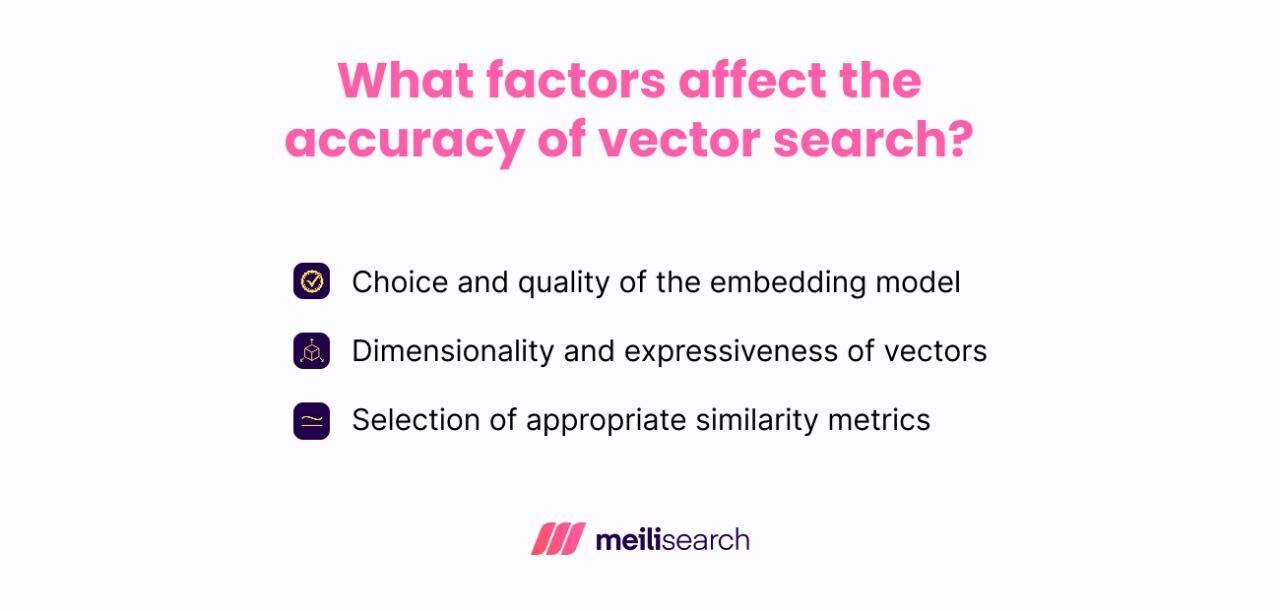
Choice and quality of the embedding model
The embedding model is the foundation of vector search. If the model is not well-trained, it will produce weak vectors, leading to less relevant results.
Dimensionality and expressiveness of vectors
Vectors carry meaning through their dimensions. If there are not enough dimensions, they might not capture enough detail. If there are too many dimensions, they can become noisy and slow down performance without improving the accuracy of the results.
Selection of appropriate similarity metrics
It matters how the system measures ‘closeness’ between vectors. Using the wrong similarity metric can throw off the search results, returning results that are mathematically close yet irrelevant.
Can you combine semantic, vector, and keyword search?
Yes, you can combine semantic search, vector search, and keyword search. The combination is called hybrid search.
Hybrid search works by running a traditional keyword search and an ANN-based vector search in parallel. The result is then normalized and merged into a single ranked list. This approach delivers the precision of keywords and the contextual depth of semantic understanding.
Hybrid search is widely used in enterprise search, large e-commerce sites, and knowledge management systems, where exact terms and semantic intent are critical.
The benefits of hybrid search are:
- Enhanced search accuracy and relevance
- Improved user experience
- Increased search speed
- Control over the level of contextual depth and keyword weights
- Ability to handle data with low computational costs
Meilisearch can be used to perform both vector search and semantic search. Let’s see how.
How does Meilisearch use vector and semantic search?
Meilisearch supports vector and semantic search, matching results to queries by keywords and meaning.
Here is a step-by-step process of how to use Meilisearch for vector or semantic search:
- Pick an embedding model: Start by choosing a model to turn your textual queries into vectors. You can use options like OpenAI’s ‘text-embedding-ada-002’, Cohere’s ‘embed-english-v2.0’, or Hugging Face models like ‘all-MiniLM-L6-v2’.
- Embed your data: Run your documents or records (the data that the user can search through) through the model to generate vector representations. These will be stored in Meilisearch for fast searching.
- Turn the user’s query into a vector: When a user performs a search, their query is converted into a vector using the same model you used to transform your data.
- Search for the closest matches: Meilisearch uses Approximate Nearest Neighbor (ANN) search to quickly find the most similar vectors – the ones with the closest meanings.
- Combine vector and keyword results: Results from the vector search are merged with traditional keyword matches, so you get a mix of smart, context-aware results and exact hits.
- Filter and rank the results: Finally, the combined results are ranked and filtered based on your settings, so you control what shows up first and what gets filtered out.
Unpacking the power behind modern search technologies
Modern search has evolved past simple keyword matching; it's now focused on understanding meaning.
Websites and apps we use daily are leveraging technologies like vector search, semantic search, and AI-powered search to understand what you mean, not just what you type.
While semantic search focuses on understanding intent, vector search uses mathematical calculations to find meaning through similarity metrics. The two searches work differently, but both can make searching more accurate.
As a developer, knowing how these tools work and when to use them can help you choose better search experiences.
Why Meilisearch strikes the balance between speed and smart search
Meilisearch is the perfect balance of speed and smart search. It can quickly catch spelling errors and simultaneously make sense of the user's intent. As a developer, you can set up vector and semantic search for your use case, allowing you to build powerful search capabilities.

